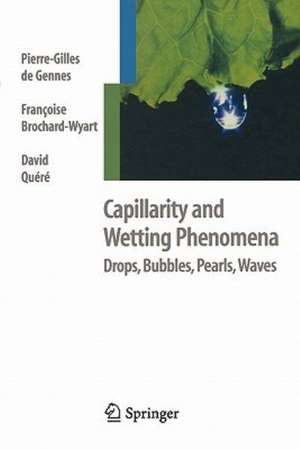Capillarity and Wetting Phenomena: Drops, Bubbles, Pearls, Waves
Autor Pierre Gilles de Gennes, Francoise Brochard-Wyart, David Quereen Limba Engleză Paperback – 25 noi 2010
| Toate formatele și edițiile | Preț | Express |
|---|---|---|
| Paperback (1) | 455.30 lei 6-8 săpt. | |
| Springer – 25 noi 2010 | 455.30 lei 6-8 săpt. | |
| Hardback (1) | 590.30 lei 6-8 săpt. | |
| Springer – 12 sep 2003 | 590.30 lei 6-8 săpt. |
Preț: 455.30 lei
Nou
Puncte Express: 683
Preț estimativ în valută:
87.12€ • 91.21$ • 72.09£
87.12€ • 91.21$ • 72.09£
Carte tipărită la comandă
Livrare economică 05-19 aprilie
Preluare comenzi: 021 569.72.76
Specificații
ISBN-13: 9781441918338
ISBN-10: 1441918337
Pagini: 308
Ilustrații: XVI, 292 p.
Dimensiuni: 155 x 235 x 16 mm
Greutate: 0.44 kg
Ediția:Softcover reprint of the original 1st ed. 2004
Editura: Springer
Colecția Springer
Locul publicării:New York, NY, United States
ISBN-10: 1441918337
Pagini: 308
Ilustrații: XVI, 292 p.
Dimensiuni: 155 x 235 x 16 mm
Greutate: 0.44 kg
Ediția:Softcover reprint of the original 1st ed. 2004
Editura: Springer
Colecția Springer
Locul publicării:New York, NY, United States
Public țintă
Lower undergraduateCuprins
1 Capillarity: Deformable Interfaces.- 2 Capillarity and Gravity.- 3 Hysteresis and Elasticity of Triple Lines.- 4 Wetting and Long-Range Forces.- 5 Hydrodynamics of Interfaces.- 6 Dynamics of the Triple Line.- 7 Dewetting.- 8 Surfactants.- 9 Special Interfaces.- 10 Transport Phenomena.
Recenzii
From the reviews:
Choice
Review by P. R. Douville, emeritus, Central Connecticut State University
"You are an intelligent spider sitting on your web. Early morning light forms tiny rainbows as it passes through the beads of dew strung along the filaments composing your hard-earned handiwork. Why beads? What happened to the water in between each drop? To answer this question, our eight-legged intellectual must first gain an understanding of how liquids such as water actually wet surfaces and why such liquids fail to wet other surfaces. The problem encompasses such subjects as liquids rising up capillary tubes, paint spreading on solid surfaces or liquids spreading on other liquids, the fascinating subject of bubble formation and stability, and why water streams down some surfaces and forms droplets on other surfaces. De Gennes (Collège ((College) de France; Institute Curie), Brochard-Wyart (Institut Curie), and Quéré (Quere) (Collège ((College) deFrance) have written an excellent treatise on these phenomena that opens with a very poetic introduction relating esoteric concepts to everyday observations, and includes chapter references, historical sketches, and a very good discussion of each problem at chapter beginnings. For readers with backgrounds in mathematics, physics, and chemistry, although it is not beyond advanced undergraduates in the sciences and technological fields. Summing Up: Highly recommended. Upper-division undergraduates through professionals; two-year technical program students."
"This book is designed as an elementary introduction to the conceptual framework used in research on wetting/dewetting processes and related capillary phenomena. … a simple and inspiring style of writing allows the authors to ‘convey the sense of curiosity and joy’ that unites researchers in this area … . The range of topics covered and a host of physical ideas and principles the authors describe as guidelines in the field are likely to make this book interesting to a wide audience … ." (Dr. Y. D. Shikhmurzaev, Contemporary Physics, Vol. 46 (1), 2005)
"Capillarity refers to the study of surface phenomena involving at least one liquid phase. … This book brings together (almost) everything which is known in a single volume. In view of the fact that the history of capillarity covers several centuries, this is a real ‘tour de force’. … It contains a wealth of practical information about a very large variety of surface phenomena. … This book should be of interest to a large variety of scientists (not only physicists)." (Marc Baus, Physicalia, Vol. 57 (3), 2005)
"Capillarity and Wetting Phenomena: Drops, Bubbles, Pearls, Waves is a translation of the earlier French Gouttes, Bulles, Perles et Ondes … . It has been wonderfully translated by Axel Reisinger. The English is fully fluent and idiomatic … . The book can be read with pleasure and profit by the uninitiated, but it is also a valuable - andeven an indispensable reference work for the expert. … contains a whole bookshelf of information – all of it useful and much of it fascinating." (Benjamin Widom, Physics Today, December, 2004)
"De Gennes (Collège ((College) de France; Institute Curie), Brochard-Wyart (Institut Curie), and Quéré (Quere) (Collège (College) de France) have written an excellent treatise … with a very poetic introduction relating esoteric concepts to everyday observations, and includes chapter references, historical sketches, and a very good discussion of each problem at chapter beginnings. … Summing Up: Highly recommended. Upper-division undergraduates through professionals: two-year technical program students." (P. R. Douville, CHOICE, May, 2004)
"The whole book is in the same spirit, which is very enjoyable … . Thus it contains many illuminating examples and sketches … . it will also act as a reference for those working in the field. In conclusion, the intended readers of this book, whether they be soft matter students or scientists or simply the curious, should find therein not just a very good source of information but also an impressive collection of exciting and simple explanations of very complex phenomena." (Dr. Roberto Cerbino, Europhysics News, Vol. 37 (1), 2006)
Choice
Review by P. R. Douville, emeritus, Central Connecticut State University
"You are an intelligent spider sitting on your web. Early morning light forms tiny rainbows as it passes through the beads of dew strung along the filaments composing your hard-earned handiwork. Why beads? What happened to the water in between each drop? To answer this question, our eight-legged intellectual must first gain an understanding of how liquids such as water actually wet surfaces and why such liquids fail to wet other surfaces. The problem encompasses such subjects as liquids rising up capillary tubes, paint spreading on solid surfaces or liquids spreading on other liquids, the fascinating subject of bubble formation and stability, and why water streams down some surfaces and forms droplets on other surfaces. De Gennes (Collège ((College) de France; Institute Curie), Brochard-Wyart (Institut Curie), and Quéré (Quere) (Collège ((College) deFrance) have written an excellent treatise on these phenomena that opens with a very poetic introduction relating esoteric concepts to everyday observations, and includes chapter references, historical sketches, and a very good discussion of each problem at chapter beginnings. For readers with backgrounds in mathematics, physics, and chemistry, although it is not beyond advanced undergraduates in the sciences and technological fields. Summing Up: Highly recommended. Upper-division undergraduates through professionals; two-year technical program students."
"This book is designed as an elementary introduction to the conceptual framework used in research on wetting/dewetting processes and related capillary phenomena. … a simple and inspiring style of writing allows the authors to ‘convey the sense of curiosity and joy’ that unites researchers in this area … . The range of topics covered and a host of physical ideas and principles the authors describe as guidelines in the field are likely to make this book interesting to a wide audience … ." (Dr. Y. D. Shikhmurzaev, Contemporary Physics, Vol. 46 (1), 2005)
"Capillarity refers to the study of surface phenomena involving at least one liquid phase. … This book brings together (almost) everything which is known in a single volume. In view of the fact that the history of capillarity covers several centuries, this is a real ‘tour de force’. … It contains a wealth of practical information about a very large variety of surface phenomena. … This book should be of interest to a large variety of scientists (not only physicists)." (Marc Baus, Physicalia, Vol. 57 (3), 2005)
"Capillarity and Wetting Phenomena: Drops, Bubbles, Pearls, Waves is a translation of the earlier French Gouttes, Bulles, Perles et Ondes … . It has been wonderfully translated by Axel Reisinger. The English is fully fluent and idiomatic … . The book can be read with pleasure and profit by the uninitiated, but it is also a valuable - andeven an indispensable reference work for the expert. … contains a whole bookshelf of information – all of it useful and much of it fascinating." (Benjamin Widom, Physics Today, December, 2004)
"De Gennes (Collège ((College) de France; Institute Curie), Brochard-Wyart (Institut Curie), and Quéré (Quere) (Collège (College) de France) have written an excellent treatise … with a very poetic introduction relating esoteric concepts to everyday observations, and includes chapter references, historical sketches, and a very good discussion of each problem at chapter beginnings. … Summing Up: Highly recommended. Upper-division undergraduates through professionals: two-year technical program students." (P. R. Douville, CHOICE, May, 2004)
"The whole book is in the same spirit, which is very enjoyable … . Thus it contains many illuminating examples and sketches … . it will also act as a reference for those working in the field. In conclusion, the intended readers of this book, whether they be soft matter students or scientists or simply the curious, should find therein not just a very good source of information but also an impressive collection of exciting and simple explanations of very complex phenomena." (Dr. Roberto Cerbino, Europhysics News, Vol. 37 (1), 2006)
















